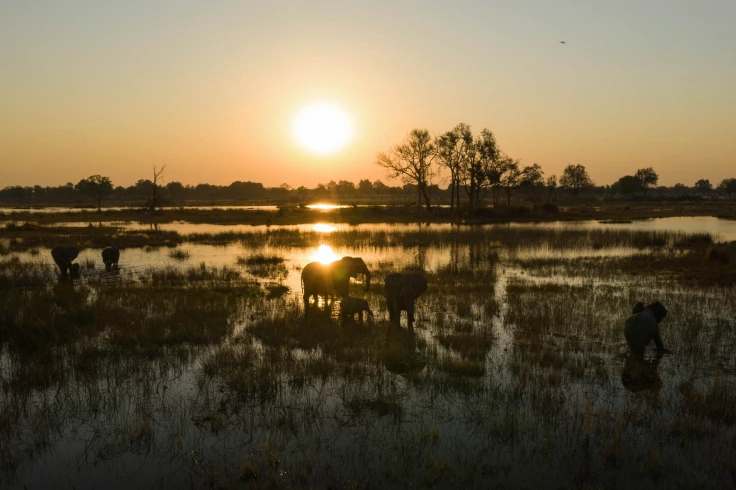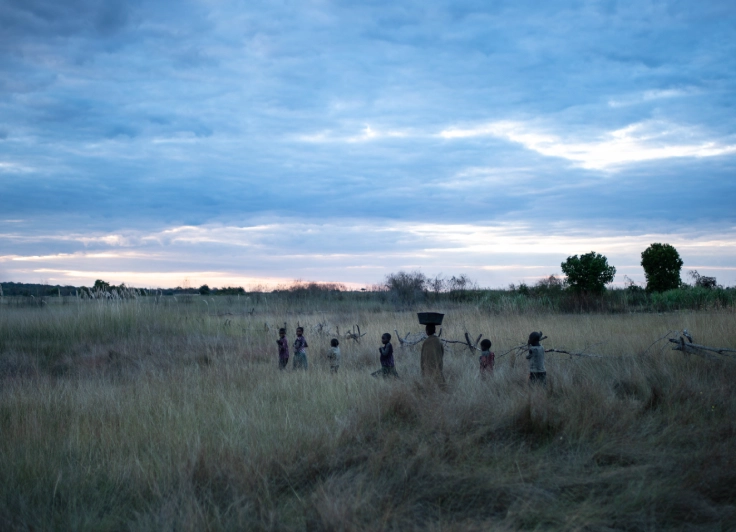In northern Botswana lies one of the world’s largest, most biodiverse wetlands – the Okavango Delta. While the Delta is protected, the critical headwaters that supply it are not: putting the future of people and wildlife that rely on them at risk.
In 2021, De Beers embarked on Okavango Eternal – a five-year partnership with National Geographic to help address one of the biggest conservation challenges in Africa: preserving the headwaters of the Okavango Delta. Alongside local communities, we are working to protect wildlife and support livelihoods across the region.

The Okavango Delta: a freshwater oasis
Situated in the middle of the Kalahari Desert in Botswana, the Okavango Delta is one of the most biodiverse areas in Africa – so large it can be seen from space. The area is ecologically significant globally, and is home to:
- The world’s largest remaining elephant population
- Large mammals and reptiles, including lions, cheetahs, crocodiles, buffalo, wild dogs, and zebra
- Hundreds of species of birds
The Okavango Delta is fed through an annual flood pulse that starts in Angola. This natural event is also a lifeline for the human population – the floods provide the main source of water for around one million people, as well as food and livelihoods. The seasonal floods also support a thriving ecotourism industry, which nourishes the landscape and wildlife that draws visitors – contributing hundreds of millions of dollars to Botswana’s economy.
Photo credit: Chris Boyes / National Geographic
A complex system of threats
The health of the basin depends on its source lakes and rivers. Their waters originate almost 1,000 kilometres and two political borders away: starting as rain in Angola’s highlands, before travelling through Namibia and into Botswana. If these waters were to stop flowing, one of Africa’s most remarkable natural treasures would stop nourishing the ecosystems that rely on it.
It’s essential that we help secure the protection of these headwaters before it’s too late. Right now, the effects of climate change, water diversion and upstream commercial agriculture are putting these ecosystems risk.
Okavango Eternal – a multi-year, multifaceted, multi-country mission
For many years, the National Geographic Okavango Wilderness Project has been working with local communities, NGOs and governments in southern Africa to help secure protection for the Okavango Basin. Since 2021, De Beers has been providing support, networks and funding to expand and accelerate these efforts, working alongside scientists, government officials, wildlife experts, journalists, photographers, NGOs, partners and National Geographic Explorers.
The overall vision of our Okavango Eternal partnership is for enhanced protection of the headwaters in Angola, to help secure the integrity of the Okavango Delta in Botswana and improve food and water security for over one million people across the Okavango River Basin. The initiative has two key objectives, aligned to our Building Forever approach; protecting nature and supporting livelihoods. It is a multi-year, multifaceted, and multi-country mission.
Using the power of storytelling
Public support is a key driver for the protection of the Okavango Basin. Storytelling – both locally and internationally – is a key focus as we aim to increase understanding of its importance.
Through Okavango Eternal, we’ve worked with local storytellers. helping to create a new documentary which showcases the importance of the Delta from the perspective of the communities who live there. Called Nkashi: Race for the Okavango – it aired on Botswana Television (BTV) and was screened to communities in 13 villages around the Delta. It has since been released on YouTube, where it has been seen globally by millions.
Okavango Eternal – Protecting a Natural Wonder

Our progress so far
To ensure long term protection of the Delta's headwaters, Okavango Eternal’s first priority was to enable stakeholder engagement – hosting symposiums and developing partnerships with local communities and institutions to support a unified and enduring approach.
We are now combining local knowledge with the latest technologies and scientific techniques to deepen understanding of the region’s ecological importance – and further strengthen the case for its protection. For example, a local team of 75 Watchers from 30 villages actively patrol and monitor nearly 5,000 km² of Angolan forest. They have been trained and equipped with motorbikes and remote camera traps to report environmental changes – while also drawing on their long-held knowledge of the forest ecosystem. Since their efforts began, they have documented species previously unrecorded in the region.
We’ve also established critical infrastructure, including new hydrological stations to expand water monitoring capabilities along more remote rivers. And we’ve been supporting the National Geographic Okavango Wilderness Project’s annual Delta crossings to monitor and compare ecosystem health and water quality, year after year.
Okavango Eternal is deepening our understanding of how ecosystems interact – sciencemapping animal migration routes, defining animal territories, and documenting more than 50 species new to academic science. This -combination of groundbreaking research and traditional knowledge is helping to build international momentum to protect cross-border corridors that wildlife to move freely and thrive.
Photo credit: Daniel Snyders / Carinè Muller / National Geographic
“Protecting these headwaters and wetlands, miombo woodland forests – the natural heritage of Angola – is one of the most critical conservation challenges in Africa today.”
National Geographic Explorer, NGOWP Project Lead
Working closely with local communities
Our partnership is also supporting the next generation of protectors, developing programmes that engage teachers and their pupils in conservation. We have launched Educators Expeditions. This program, immerses teachers in the Delta’s abundance of nature and traditional knowledge – which they then incorporate in classroom lessons. We support local scientists, sponsoring internships and PhD research to ensure that the future stewardship of the Okavango Basin is locally led.
Our work to protect nature also creates livelihood opportunities that strengthen local economies and support conservation. For example, programmes are underway to develop regenerative agriculture, beekeeping, artisanal groups and midwifery training in Angola, alongside sustainable cattle husbandry, entrepreneurship support and ecotourism opportunities in Botswana.
De Beers is proud to be working alongside National Geographic, dedicating resources and efforts to help preserve one of the world’s most remarkable natural wonders.


